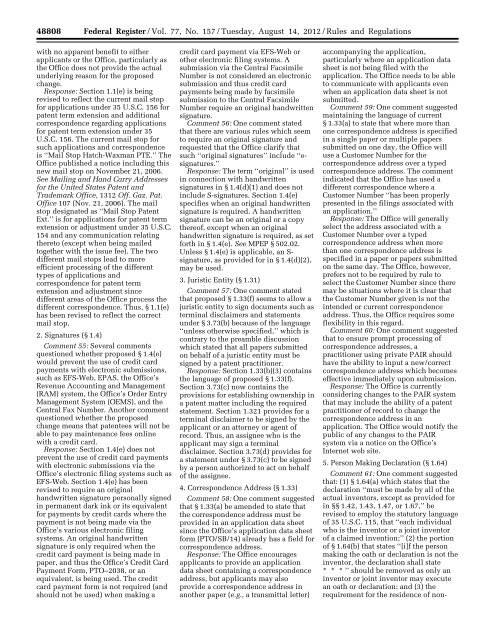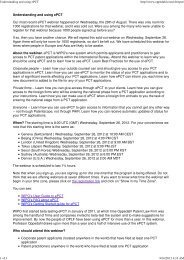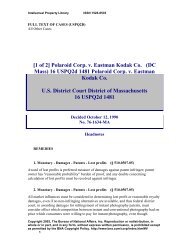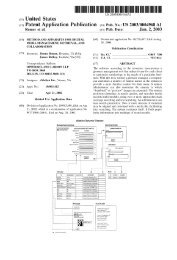48808 Federal Register / Vol. 77, No. 157 / Tuesday, August 14, 2012 / Rules and Regulationssro<strong>be</strong>rts on DSK5SPTVN1PROD with RULESwith no apparent <strong>be</strong>nefit to eitherapplicants or the Office, particularly asthe Office does not provide the actualunderlying reason for the proposedchange.Response: Section 1.1(e) is <strong>be</strong>ingrevised to reflect the current mail stopfor applications under 35 U.S.C. 156 forpatent term extension and additionalcorrespondence regarding applicationsfor patent term extension under 35U.S.C. 156. The current mail stop forsuch applications and correspondenceis ‘‘Mail Stop Hatch-Waxman PTE.’’ TheOffice published a notice including thisnew mail stop on Novem<strong>be</strong>r 21, 2006.See Mailing and Hand Carry Addressesfor the United States Patent andTrademark Office, 1312 Off. Gaz. Pat.Office 107 (Nov. 21, 2006). The mailstop designated as ‘‘Mail Stop PatentExt.’’ is for applications for patent termextension or adjustment under 35 U.S.C.154 and any communication relatingthereto (except when <strong>be</strong>ing mailedtogether with the issue fee). The twodifferent mail stops lead to moreefficient processing of the differenttypes of applications andcorrespondence for patent termextension and adjustment sincedifferent areas of the Office process thedifferent correspondence. Thus, § 1.1(e)has <strong>be</strong>en revised to reflect the correctmail stop.2. Signatures (§ 1.4)Comment 55: Several commentsquestioned whether proposed § 1.4(e)would prevent the use of credit cardpayments with electronic submissions,such as EFS-Web, EPAS, the Office’sRevenue Accounting and Management(RAM) system, the Office’s Order EntryManagement System (OEMS), and theCentral Fax Num<strong>be</strong>r. Another commentquestioned whether the proposedchange means that patentees will not <strong>be</strong>able to pay maintenance fees onlinewith a credit card.Response: Section 1.4(e) does notprevent the use of credit card paymentswith electronic submissions via theOffice’s electronic filing systems such asEFS-Web. Section 1.4(e) has <strong>be</strong>enrevised to require an originalhandwritten signature personally signedin permanent dark ink or its equivalentfor payments by credit cards where thepayment is not <strong>be</strong>ing made via theOffice’s various electronic filingsystems. An original handwrittensignature is only required when thecredit card payment is <strong>be</strong>ing made inpaper, and thus the Office’s Credit CardPayment Form, PTO–2038, or anequivalent, is <strong>be</strong>ing used. The creditcard payment form is not required (andshould not <strong>be</strong> used) when making acredit card payment via EFS-Web orother electronic filing systems. Asubmission via the Central FacsimileNum<strong>be</strong>r is not considered an electronicsubmission and thus credit cardpayments <strong>be</strong>ing made by facsimilesubmission to the Central FacsimileNum<strong>be</strong>r require an original handwrittensignature.Comment 56: One comment statedthat there are various rules which seemto require an original signature andrequested that the Office clarify thatsuch ‘‘original signatures’’ include ‘‘esignatures.’’Response: The term ‘‘original’’ is usedin connection with handwrittensignatures in § 1.4(d)(1) and does notinclude S-signatures. Section 1.4(e)specifies when an original handwrittensignature is required. A handwrittensignature can <strong>be</strong> an original or a copythereof, except when an originalhandwritten signature is required, as setforth in § 1.4(e). See MPEP § 502.02.Unless § 1.4(e) is applicable, an S-signature, as provided for in § 1.4(d)(2),may <strong>be</strong> used.3. Juristic Entity (§ 1.31)Comment 57: One comment statedthat proposed § 1.33(f) seems to allow ajuristic entity to sign documents such asterminal disclaimers and statementsunder § 3.73(b) <strong>be</strong>cause of the language‘‘unless otherwise specified,’’ which iscontrary to the preamble discussionwhich stated that all papers submittedon <strong>be</strong>half of a juristic entity must <strong>be</strong>signed by a patent practitioner.Response: Section 1.33(b)(3) containsthe language of proposed § 1.33(f).Section 3.73(c) now contains theprovisions for establishing ownership ina patent matter including the requiredstatement. Section 1.321 provides for aterminal disclaimer to <strong>be</strong> signed by theapplicant or an attorney or agent ofrecord. Thus, an assignee who is theapplicant may sign a terminaldisclaimer. Section 3.73(d) provides fora statement under § 3.73(c) to <strong>be</strong> signedby a person authorized to act on <strong>be</strong>halfof the assignee.4. Correspondence Address (§ 1.33)Comment 58: One comment suggestedthat § 1.33(a) <strong>be</strong> amended to state thatthe correspondence address must <strong>be</strong>provided in an application data sheetsince the Office’s application data sheetform (PTO/SB/14) already has a field forcorrespondence address.Response: The Office encouragesapplicants to provide an applicationdata sheet containing a correspondenceaddress, but applicants may alsoprovide a correspondence address inanother paper (e.g., a transmittal letter)VerDate Mar2010 17:28 Aug 13, 2012 Jkt 226001 PO 00000 Frm 00034 Fmt 4701 Sfmt 4700 E:\FR\FM\14AUR6.SGM 14AUR6accompanying the application,particularly where an application datasheet is not <strong>be</strong>ing filed with theapplication. The Office needs to <strong>be</strong> ableto communicate with applicants evenwhen an application data sheet is notsubmitted.Comment 59: One comment suggestedmaintaining the language of current§ 1.33(a) to state that where more thanone correspondence address is specifiedin a single paper or multiple paperssubmitted on one day, the Office willuse a Customer Num<strong>be</strong>r for thecorrespondence address over a typedcorrespondence address. The commentindicated that the Office has used adifferent correspondence where aCustomer Num<strong>be</strong>r ‘‘has <strong>be</strong>en properlypresented in the filings associated withan application.’’Response: The Office will generallyselect the address associated with aCustomer Num<strong>be</strong>r over a typedcorrespondence address when morethan one correspondence address isspecified in a paper or papers submittedon the same day. The Office, however,prefers not to <strong>be</strong> required by rule toselect the Customer Num<strong>be</strong>r since theremay <strong>be</strong> situations where it is clear thatthe Customer Num<strong>be</strong>r given is not theintended or current correspondenceaddress. Thus, the Office requires someflexibility in this regard.Comment 60: One comment suggestedthat to ensure prompt processing ofcorrespondence addresses, apractitioner using private PAIR shouldhave the ability to input a new/correctcorrespondence address which <strong>be</strong>comeseffective immediately upon submission.Response: The Office is currentlyconsidering changes to the PAIR systemthat may include the ability of a patentpractitioner of record to change thecorrespondence address in anapplication. The Office would notify thepublic of any changes to the PAIRsystem via a notice on the Office’sInternet web site.5. Person Making Declaration (§ 1.64)Comment 61: One comment suggestedthat: (1) § 1.64(a) which states that thedeclaration ‘‘must <strong>be</strong> made by all of theactual inventors, except as provided forin §§ 1.42, 1.43, 1.47, or 1.67,’’ <strong>be</strong>revised to employ the statutory languageof 35 U.S.C. 115, that ‘‘each individualwho is the inventor or a joint inventorof a claimed invention;’’ (2) the portionof § 1.64(b) that states ‘‘[i]f the personmaking the oath or declaration is not theinventor, the declaration shall state* * * ’’ should <strong>be</strong> removed as only aninventor or joint inventor may executean oath or declaration; and (3) therequirement for the residence of non-
Federal Register / Vol. 77, No. 157 / Tuesday, August 14, 2012 / Rules and Regulations48809sro<strong>be</strong>rts on DSK5SPTVN1PROD with RULESinventors who sign should <strong>be</strong> removed.Another comment suggested that § 1.64<strong>be</strong> amended to reflect that a single oathor declaration document is not requiredand to eliminate the requirement for theresidence and mailing address of thelegal representative.Response: In response to thecomments, the provisions of former§ 1.64 have <strong>be</strong>en eliminated. Section1.64 now provides for a substitutestatement in lieu of an oath ordeclaration and requires the residenceand mailing of address of the personsigning the substitute statement. TheOffice needs this information foridentification purposes and to <strong>be</strong> able tocommunicate with the person executingthe substitute statement in the eventthat this <strong>be</strong>comes necessary.6. Noncompliant Declarations (§ 1.67)Comment 62: One comment statedthat proposed § 1.67 included a criticalmisconception that a declaration may <strong>be</strong>made by someone other than theinventor. Additionally, the commentstated that it is unclear how a deficiencyor inaccuracy relating to fewer than allthe applicants could <strong>be</strong> cured by aninventor’s declaration. Anothercomment stated that § 1.67 should <strong>be</strong>amended to reflect that a single oath ordeclaration document is not required.Response: Initially, it should <strong>be</strong> notedthat § 1.67 is directed to supplementaloaths or declarations and provides amechanism for applicants to correctdeficiencies or inaccuracies present inan earlier-filed inventor’s oath ordeclaration. Section 1.67, in this finalrule, prohibits the Office from requiringa person who has executed an oath ordeclaration that is in compliance with35 U.S.C. 115 and § 1.63 or § 1.162 toprovide an additional inventor’s oath ordeclaration for the application.However, the Office is not prohibitedfrom requiring a new oath or declarationin compliance with 35 U.S.C. 115 and§ 1.63 where the oath or declaration thatwas submitted does not comply with 35U.S.C. 115 and § 1.63. The Office notesthat former § 1.47(b) permitted anassignee to sign the oath or declarationfor the nonsigning inventor where noinventors were available. The assigneewould simply make the statements inthe oath or declaration on informationand <strong>be</strong>lief. See former § 1.64(b). Section1.63(f), in this final rule, provides thatany reference to the inventor’s oath ordeclaration in this chapter means theoaths, declarations, or substitutestatements that have <strong>be</strong>en collectivelyexecuted by or with respect to all of thejoint inventors. Accordingly, a singleoath or declaration document is notrequired under § 1.63 or § 1.67. Since§ 1.63 is amended to only require thatthe oath or declaration identify theinventor or joint inventor executing theoath or declaration rather, thanidentifying the entire inventive entity,§ 1.67 no longer refers to a deficiency orinaccuracy relating to fewer than all ofthe inventors or applicants.7. Statement Under § 3.73Comment 63: One commentsupported the proposed change to§ 3.73, but suggested a modification of§ 3.73(b). The comment noted thedifficulties practitioners face inattempting to reproduce reel and framenum<strong>be</strong>rs, including time, effort and thepotential for typographical errors fromthe hand-keying required when formPTO/SB/96 is completed, and the needfor Office personnel to check theinformation character by character. Thecomment suggested that these effortscan <strong>be</strong> limited by permitting attachmentof a copy of the Abstract of Title orNotice of Recordation where theycontain the reel and frame num<strong>be</strong>rs.Response: Section 3.73(c)(1)(i)requires documentary evidence of achain of title from the original owner tothe assignee. A copy of an executedassignment is only one example of thetype of documentary evidence that may<strong>be</strong> submitted. Other types ofdocumentary evidence may <strong>be</strong>submitted. An Abstract of Title orNotice of Recordation would <strong>be</strong>insufficient documentary evidence sinceany person can submit documents forrecordation to Assignment RecordationBranch, therefore an Abstract of Titlemay list extraneous or erroneousdocuments unrelated to the chain oftitle.Comment 64: One comment statedthat, with respect to proposed§ 3.73(c)(3), the applicants should <strong>be</strong>allowed to also file a copy of a statementunder § 3.73(b) that was originally filedin a provisional application in anonprovisional application that claims<strong>be</strong>nefit of the provisional application.Response: Section 3.73 does notprovide for the filing of a copy of astatement under § 3.73(c) in anonprovisional application that wasoriginally filed in a prior application,such as a provisional application whose<strong>be</strong>nefit is <strong>be</strong>ing claimed in thenonprovisional application. Generally,there is no need to file a § 3.73(c)statement in a provisional applicationand such statements are not usuallyfiled in provisional applications as suchapplications are not examined and donot undergo prosecution. Furthermore,where an assignee has filed such astatement in the provisional application,the assignee would presumably <strong>be</strong> theVerDate Mar2010 17:28 Aug 13, 2012 Jkt 226001 PO 00000 Frm 00035 Fmt 4701 Sfmt 4700 E:\FR\FM\14AUR6.SGM 14AUR6applicant filing the nonprovisionalapplication. An assignee who is theapplicant who filed the applicationneed not to file a § 3.73(c) statement.Comment 65: One comment statedthat, with respect to proposed§ 3.73(c)(3), if a statement under§ 3.73(b) in the earlier application isfrom an assignee, it should not <strong>be</strong>required that the inventorship of thecontinuing application <strong>be</strong> the same as orless than that of the earlier application,if the newly added inventors have alsoassigned, or are under an obligation toassign, to the same assignee and theassignment is recorded at the Office.Response: Section 3.73 does notprovide for the filing of a copy of astatement under § 3.73(c) in acontinuing application that wasoriginally filed in the prior application.Where an assignee has filed a statementunder § 3.73(c) in a prior application,the assignee may file the continuingapplication as the applicant and wouldnot need to file a § 3.73(c) statement.Comment 66: One comment suggestedthat the Office simplify the processrelating to the power of attorney from anassignee such that the power of attorneydocument(s) may <strong>be</strong> filed concurrentlywith the filing of patent applicationdocuments. The comment noted that theOffice’s form (PTO/SB/96) requiresentry of specific application data whichare only available after filing of thepatent application.Response: An assignee who is theapplicant will not need to comply withthe procedure in §§ 3.71 and 3.73,including filing a § 3.73(c) statement(e.g., Form PTO/SB/96). The assigneewill only need to identify him or herselfas the applicant and submit a power ofattorney. Thus, the assignee will <strong>be</strong> ableto file the power of attorneydocument(s) concurrently with thepatent application documents eventhough he or she does not have anapplication num<strong>be</strong>r for the application.An assignee who did not file theapplication and thus is not the originalapplicant would need to file a § 3.73(c)statement to <strong>be</strong>come the applicant andtake over prosecution of the application.See §§ 1.46(c), 3.71, and 3.73.8. Lack of Deceptive IntentComment 67: One comment expressedconcern about the deletion of the ‘‘lackof deceptive intent’’ clause. Onecomment suggested thatnotwithstanding the acknowledgementthat willful false statements arepunishable by fine or imprisonment,keeping the ‘‘without deceptiveintention’’ in the statute may <strong>be</strong> a goodidea. The comment noted that there may<strong>be</strong> semantic differences <strong>be</strong>tween ‘‘false
- Page 1:
UNIFORM CERTIFICATE OF ATTENDANCE F
- Page 4 and 5:
SPTO explains the America Invents A
- Page 6 and 7:
PTO/SB/01A (01-09)Approved for use
- Page 8 and 9:
PTO/SB/ (06-12)Approved for use thr
- Page 10 and 11:
PTO/ (06-12)Approved for use throug
- Page 12 and 13:
PTO/(06-1Approved for use through 0
- Page 14 and 15:
What will change about the oath ord
- Page 16 and 17:
Action item●●●If you have not
- Page 18 and 19:
But 37 CFR § 1.63 says:A person ma
- Page 20 and 21:
●●●Combined assignment anddec
- Page 22 and 23:
●●●●●●Consequences of i
- Page 24 and 25:
How to file the ADSs●●If you pr
- Page 26 and 27:
Supplemental ADSAny ADS filed after
- Page 28 and 29:
Provisionals●●●Rules are a bi
- Page 30 and 31:
Are all assignees applicants?●●
- Page 32 and 33:
Substitute Statement●●●This f
- Page 34 and 35: ●●●Docket consequences of the
- Page 36 and 37: New Rule-46 practice67●●●Rule
- Page 38 and 39: Consequences of AIA for PCT filers
- Page 40 and 41: If you are entrusted the US nationa
- Page 42 and 43: ●●●Choosing between a “bypa
- Page 44 and 45: ●●●Getting your name and addr
- Page 46 and 47: Exercises relating to September 16,
- Page 48 and 49: Important AIA webinar September 6
- Page 50 and 51: Exercises relating to September 16,
- Page 52 and 53: 48776 Federal Register / Vol. 77, N
- Page 54 and 55: sroberts on DSK5SPTVN1PROD with RUL
- Page 56 and 57: sroberts on DSK5SPTVN1PROD with RUL
- Page 58 and 59: sroberts on DSK5SPTVN1PROD with RUL
- Page 60 and 61: sroberts on DSK5SPTVN1PROD with RUL
- Page 62 and 63: sroberts on DSK5SPTVN1PROD with RUL
- Page 64 and 65: sroberts on DSK5SPTVN1PROD with RUL
- Page 66 and 67: sroberts on DSK5SPTVN1PROD with RUL
- Page 68 and 69: sroberts on DSK5SPTVN1PROD with RUL
- Page 70 and 71: sroberts on DSK5SPTVN1PROD with RUL
- Page 72 and 73: sroberts on DSK5SPTVN1PROD with RUL
- Page 74 and 75: 48798 Federal Register / Vol. 77, N
- Page 76 and 77: 48800 Federal Register / Vol. 77, N
- Page 78 and 79: 48802 Federal Register / Vol. 77, N
- Page 80 and 81: 48804 Federal Register / Vol. 77, N
- Page 82 and 83: 48806 Federal Register / Vol. 77, N
- Page 86 and 87: 48810 Federal Register / Vol. 77, N
- Page 88 and 89: 48812 Federal Register / Vol. 77, N
- Page 90 and 91: 48814 Federal Register / Vol. 77, N
- Page 92 and 93: 48816 Federal Register / Vol. 77, N
- Page 94 and 95: sroberts on DSK5SPTVN1PROD with RUL
- Page 96 and 97: sroberts on DSK5SPTVN1PROD with RUL
- Page 98 and 99: 48822 Federal Register / Vol. 77, N
- Page 100 and 101: sroberts on DSK5SPTVN1PROD with RUL
- Page 102: 48826 Federal Register / Vol. 77, N





